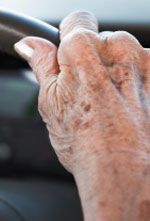Publication
Article
Psychiatric Times
Can Your Older Patient Drive Safely?
Author(s):
Medical professionals may be reluctant to initiate a discussion about driving with older patients in anticipation of a negative impact on the physician-patient relationship.

Approximately 22 million older adults (78%) have valid drivers' licenses, and the number will grow until 2029 as the baby boomer generation ages.1 This dramatic change in demographics will be reflected in the driving population, so there will be a greater need for cost-effective and valid methods for identifying at-risk older drivers.2
A variety of age-related medical and cognitive conditions affect driving fitness. There is a great deal of heterogeneity in how people age as well as in the time course of age-related decline. Inevitably, changes in cognitive and perceptual abilities occur that are directly relevant to driving. Increased age is associated with diminished visual and auditory perception, with decreased visual fields, poor visual acuity, decreased glare resistance, and hearing loss.
Normal aging does not affect all cognitive processes required for driving, but in many older adults, vigilance and the ability to multitask are affected and reaction time and processing speed are slowed.3,4 Given the physical changes that occur with age, it is not surprising that there are considerably higher crash rates for older drivers. Drivers older than 85 have more motor vehicle accidents than new drivers younger than 19. The Insurance Institute for Highway Safety reports that fatal crash rates per mile driven are higher for drivers older than 80 than for any other age-group except teenagers.5
The relationship between increased age and driving is further complicated by the increased incidence of dementia in older adults. The prevalence of dementia in Americans older than 71 is nearly 14%, and the prevalence increases to 37% in persons 90 or older.6
Patients with Parkinson disease (PD) and Alzheimer disease (AD) are susceptible to impaired driving, and their driving skills are further compromised by problems with route-finding or navigation.4,7,8 Some patients with early, mild dementia retain safe driving skills but their risk of getting lost because of memory and visuospatial deficits may be increased.9,10 Patients with early AD have up to 7 times the crash risk of drivers without AD.11 Patients with PD often have fluctuations in attention, alertness, and motor functions because of the disease and also because of the adverse effects of medications.
Although the functional impairment in patients with dementia may wax and wane, in general, drivers are slower, make more errors at intersections, are less aware of other drivers, have less lane control, and engage in more frequent and unexpected braking.12 Despite memory loss and other cognitive problems, procedural memory (ie, skill-based knowledge) is often preserved with dementia. This means that many individuals with dementia retain the mechanical and procedural skills needed to drive. Paradoxically, the relative preservation of skill-based memory poses a problem for individuals with dementia who may lack awareness of their cognitive and perceptual limitations and who may insist on driving.
What is already known about assessing older adults for driving impairment?
Office-based driving tests sample multiple domains-such as processing speed, visual attention, and executive function-using predictive tests, including the Trail Making Test, Useful Field of View test, and Mini-Mental Status Exam. However, office-based predictive tests are not an adequate substitute for a road test, which is the gold standard of driving assessment..
What new information does this article provide?
This article reviews the data on factors that affect driving ability and the utility of available predictive tests. Recommendations for encouraging at-risk drivers to stop driving and for easing the transition to driving cessation are included.
What are the implications for psychiatric practice?
Recommendations for driving screening measures, factors to consider in driving cessation, and recommendations for approaching driving cessation with a patient and family have immediate relevancy in daily psychiatric practice.
Regulatory policies and medical recommendations
Physicians are often asked to make judgments regarding an older person's ability to drive, and psychiatrists may be called in for consultation. Many physicians look to professional organizations for guidelines on driving, but such guidelines are variable. The American Academy of Neurology (AAN) recommends that caregiver ratings of a patient's driving ability, history of crashes or citations, reduced driving mileage, and severity of dementia be used as predictors of driving competence. The AAN discourages the use of a patient's self-report of driving ability.13 The AAN also promulgates guidelines regarding the relationship between severity of dementia and driving fitness. It recommends that driving cessation be encouraged for patients with a Clinical Dementia Rating Scale of 1, which indicates mild symptoms of dementia but along with other factors translates to moderate risk.13
Ethical guidelines from the AMA prioritize driving safety over patient confidentiality; they encourage physicians to notify their state's Department of Motor Vehicles (DMV) when they suspect that a patient is unsafe to drive, and they defer to state medical societies. The AMA emphasizes the need for protections regarding physician liability for reporting unsafe drivers. Continuing education courses sponsored by the AMA have helped clinicians adopt in-office screening to assess and document driver safety.14
Drivers are expected to disclose relevant medical conditions (eg, dementia, epilepsy, PD) to their state's DMV. Six states (California, Delaware, Oregon, Nevada, New Jersey, and Pennsylvania) have issued laws that require physicians to report persons with neurological disabilities that might impair driving; California and Oregon require physicians to report patients with dementia.15 However, most states give physicians the discretion to choose whether to report a driver whose condition requires consideration by the DMV.
The legal determination of the inability to safely drive is made by the DMV. Medical qualifications for operators of motor vehicles vary across states, and there is no national legal standard for the identification of an at-risk driver. Across the US, regulations vary with respect to license renewal policies, the age at which one is considered old, and whether physicians are mandated reporters of individuals with dementia. Physicians who observe laws in good faith have full legal immunity in most states; however, in some states (eg, Arkansas, Georgia), physicians risk lawsuits for reporting a patient with questionable driving abilities because it breaches patient-physician privilege. In still other states (eg, Michigan, Montana), physicians can be held liable if a patient who is deemed to be “sound” based on medical standards later has an at-fault accident. The AAA Foundation for Traffic Safety Web site maintains a listing of each state's requirements for unsafe drivers.16
Assessment approaches
Despite requests to determine a patient's driving safety, many physicians do not feel competent to make such a decision because of the time required for assessment and lack of expertise and because they often do not understand their role in driver reporting. They rely on expertise from other health care providers who use road tests and/or office-based predictive tests.17 Office-based driving tests sample multiple domains, such as processing speed, visual attention, and executive function.
The Trail Making Test (TMT) is a commonly used predictive driving assessment. Data suggest that the TMT is useful in the identification of impaired drivers in a clinical driving competency program, as is a less culturally biased TMT analog, the Color Trails Test.18,19 The AMA recommends the TMT as a screening tool in predictive driving evaluations.20 The TMT Part B has been shown to predict at-fault motor vehicle collisions (MVCs) at the 90th percentile.21 The National Highway Traffic Safety Administration and American Association of Motor Vehicle Administrators support the use of the TMT and the Mini-Mental Status Exam (MMSE) as predictive tests of driving ability and as tools to identify persons who warrant further evaluation, but they note that these tests cannot be used to preclude licensure.22
The Useful Field of View (UFOV) test has also been shown to have predictive validity for driving ability.23 The UFOV measures the amount of information that a driver can attend to on a computer screen. A 40% UFOV reduction is considered “unsafe to drive” because of the loss of peripheral information. Those who struggle on the UFOV are about twice as likely to have an at-fault MVC.21 In a study of about 2000 participants older than 55, high-risk drivers were identified through cognitive testing. The combination of UFOV and TMT results predicted at-fault MVCs. In addition, slower TMT and slower UFOV performance were associated with a 2-fold increase in MVCs.21 However, Langford24 cautioned that predictive tests, such as the UFOV, are not accurate enough to be the sole factor in license revocation.
The MMSE is a predictive measure of driving. A cutoff score of 24 on the 30-point test indicates that a road test is warranted. A score of 24/30 on the MMSE indicates a 70% chance of failure on the road test while a score of 19/30 indicates a 95% chance of failure. But the DMV notes that even a score of 30/30 on the MMSE does not preclude the possibility of road test failure.22
Office-based testing is helpful, but it is no substitute for a road test. The road test is the gold standard of driving assessment. Multiple driving tasks are assessed (eg, starting the car, following road signs, using signals, maneuvering, controlling speed, solving problems). A number of studies have shown that individuals with mild dementia are capable of normal performance on road tests. For instance, Ott and colleagues9 found that the majority of subjects with early AD passed road tests. Similarly, Classen and colleagues25 showed that nearly 44% of patients with mild to moderate PD were able to pass road tests.
Considerations in driving cessation
Driving is a highly valued and socially important activity that is tied to one's sense of self-esteem and personal efficacy. Studies have shown that individuals who do not drive are more prone to social isolation, depression, early nursing home admission, increased health care costs, and decreased quality of life.26-28 Given the pragmatic and social ramifications of driving cessation, decisions about each person's driving fitness must be carefully considered. As noted, research studies indicate that decisions about driving cessation should not be made solely on the basis of advanced age or medical diagnosis. Instead, an evidenced-based approach is recommended.
When mild dementia is detected on office-based testing, a road test should be conducted. Individuals who have moderate or severe dementia should be counseled not to drive. The possibility of future driving cessation should be discussed before the onset of a medical condition that might impair driving. A number of steps can be taken to encourage the at-risk driver to stop driving. Some health providers advocate the use of a contract to provide guidelines regarding circumstances that should prompt driving cessation. Discussions should focus on risk to others and frame potential problems in medical terms. Potential legal and insurance issues should be reviewed. Loss of driving privileges will likely lead to reduced mobility and a lack of access to important work and leisure pursuits; thus, it is critical to identify transportation resources or to initiate a move to a place with adequate transportation resources. Family members can help identify resources and reinforce the need for driving cessation.
Conclusion
While a diagnosis of mild to moderate dementia does not necessarily preclude driving, physicians must glean information by screening for possible safety issues, initiate conversations about driving with every patient older than 70, and document the discussion in the medical record. They should also inquire about driving history, including recent accidents and near misses; confidence in driving skills; nervousness when driving; use of medications; and getting lost on familiar routes. In addition, they should probe for psychiatric issues (eg, anxiety, depression, psychosis), adverse effects of medications, and physical limitations that might affect driving.
Family concerns and cognitive function are significantly associated with road test performance and family members should be included in an assessment.29 If there is concern about unsafe driving, the patient can be referred to a hospital-based occupational therapy program for a road test.
Medical professionals may be reluctant to initiate a discussion about driving with older patients in anticipation of a negative impact on the physician-patient relationship. However, they should consider this a part of medical care that is important to ensure personal and public safety.
References:
References
1. Insurance Institute for Highway Safety. Q&A: older drivers: December 2010. http://www.iihs.org/research/qanda/older_people.html. Accessed June 19, 2012.
2. Dobbs BM. Aging baby boomers-a blessing or challenge for driver licensing authorities. Traffic Inj Prev. 2008;9:379-386.
3. Owsley C, Ball K, McGwin G Jr, et al. Visual processing impairment and risk of motor vehicle crash among older adults. JAMA. 1998;279:1083-1088.
4. Uc EY, Rizzo M, Anderson SW, et al. Impaired navigation in drivers with Parkinson's disease. Brain. 2007;130(pt 9):2433-2440.
5. Insurance Institute for Highway Safety. Fatality facts 2009: older people. http://www.iihs.org/research/fatality_facts_2009/olderpeople.html. Accessed June 19, 2012
6. Plassman BL, Langa KM, Fisher GG, et al. Prevalence of dementia in the United States: the aging, demographics, and memory study. Neuroepidemiology. 2007;29:125-132.
7. Grace J, Amick MM, D'Abreu A, et al. Neuropsychological deficits associated with driving performance in Parkinson's and Alzheimer's disease. J Int Neuropsychol Soc. 2005;11:766-775.
8. Uc EY, Rizzo M, Anderson SW, et al. Driver route-following safety errors in early Alzheimer disease. Neurology. 2004;63:832-837.
9. Ott BR, Heindel WC, Papandonatos GD, et al. A longitudinal study of drivers with Alzheimer disease. Neurology. 2008;70:1171-1178.
10. Reger MA, Welsh RK, Watson GS, et al. The relationship between neuropsychological functioning and driving ability in dementia: a meta-analysis. Neuropsychology. 2004;18:85-93.
11. Dubinsky RM, Stein AC, Lyons D. Practice parameter: risk of driving and Alzheimer's disease (an evidence-based review): report of the quality standards subcommittee of the American Academy of Neurology. Neurology. 2000;54:2205-2211.
12. Duchek JM, Carr DB, Hunt L, et al. Longitudinal driving performance in early-stage dementia of the Alzheimer type. J Am Geriatr Soc. 2003;51:1342-1347.
13. Iverson DJ, Gronseth GS, Reger MA, et al; Quality Standards Subcommittee of the American Academy of Neurology. Practice parameter update: evaluation and management of driving risk in dementia. Neurology. 2010;74:1316-1324.
14. Meuser TM, Carr DB, Irmiter C, et al. The American Medical Association Older Driver Curriculum for health professionals: changes in trainee confidence, attitudes and practice behavior. Gerontol Geriatr Educ. 2010;31:290-309.
15. Drazkowsk JF, Sirven JI. Driving and neurologic disorders. Neurology. 2011;76(7 suppl 2):S44-S49.
16. AAA Foundation for Traffic Safety. Driver licensing policies and practices. http://lpp.seniordrivers.org. Accessed June 19, 2012.
17. Bogner HR, Straton JB, Gallo JJ, et al. The role of physicians in assessing older drivers: barriers, opportunities, and strategies. J Am Board Fam Pract. 2004;17:38-43.
18. Deveney C, Najmi S, Kapust LR, et al. Neuropsychological predictors of driving performance. Paper presented at: 34th Annual Meeting of the International Neuropsychological Society; February 1-4, 2006; Boston.
19. Elkin-Frankston S, Lebowitz BK, Kapust LR, et al. The use of the Color Trails Test in the assessment of driver competence: preliminary report of a culture-fair instrument. Arch Clin Neuropsychol. 2007;22:631-635.
20. Wang CC, Kosinski CJ, Schwartzberg JG, Shanklin AV. AMA physician's guide to assessing and counseling older drivers. http://www.ama-assn.org/ama/pub/physician-resources/public-health/promoting-healthy-lifestyles/geriatric-health/older-driver-safety/assessing-counseling-older-drivers.page?. Accessed June 19, 2012.
21. Ball KK, Roenker DL, Wadley VG, et al. Can high-risk older drivers be identified through performance-based measures in a Department of Motor Vehicles setting? J Am Geriatr Soc. 2006;54:77-84.
22. National Highway Traffic Safety Administration. Driver Fitness Medical Guidelines: September 2009. http://www.nhtsa.gov/DOT/NHTSA/Traffic%20Injury%20Control/Articles/Associated%20Files/811210.pdf. Accessed June 19, 2012.
23. Owsley C. Vision and driving in the elderly. Optom Vis Sci. 1994;71:727-735.
24. Langford J. Usefulness of off-road screening tests to licensing authorities when assessing older driver fitness to drive. Traffic Inj Prev. 2008;9:328-335.
25. Classen S, Witter DP, Lanford DN, et al. Usefulness of screening tools for predicting driving performance in people with Parkinson's disease. Am J Occup Ther. 2011;65:579-588.
26. Freeman EE, Gange SJ, Muñoz B, West SK. Driving status and risk of entry into long-term care in older adults. Am J Public Health. 2006;96:1254-1259.
27. Marottoli RA, Mendes de Leon CF, Glass TA, et al. Driving cessation and increased depression symptoms: prospective evidence from the New Haven EPESE. Established Populations for Epidemiologic Studies of the Elderly. J Am Geriatr Soc. 1997;45:202-206.
28. Marottoli RA, de Leon CFM, Glass TA, et al. Consequences of driving cessation: decreased out-of-home activity levels. J Gerontol B Psychol Sci Soc Sci. 2000;55:S334-S340.
29. O'Connor MG, Kapust LR, Lin B, et al. The 4Cs (crash history, family concerns, clinical condition, and cognitive functions): a screening tool for the evaluation of the at-risk driver. J Am Geriatr Soc. 2010;58:1104-1108.




























